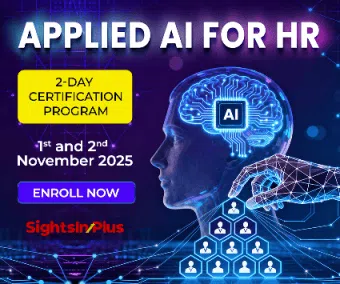The function of Employee Experience is Equal to Business Experience i.e., f(Ex)=Bx, Ex: Employee Experience, Bx: Business Experience
The role of Human Resources (HR) has evolved over the years from a tactical/operational to a strategic HR business partner (HRBP).
Even though the advent of AI tools like chatGPT/Google BARD may be ready to answer employees’ queries and provide ready guidance in the future, the need to connect individual employees emotionally and create a greater employee experience (Ex) with a sense of purpose, will remain as one of the prime responsibilities for HR professionals.
This is also in line with Richard Branson’s famous statement “Clients do not come first. Employees come first. If you take care of your employees, they will take care of the clients.”
The role of HR is to create an inclusive culture of collaboration & performance wherein employees feel valued and perform to the best of their potential and in turn have greater employee experience (Ex).
HRBPs can be a catalyst to business being a fulcrum between business stakeholders and various COE stakeholders to leverage employee experience (Ex) to deliver proportionate business experience (Bx) i.e., the function of employee experience f(Ex) is to be equal to business experience (Bx). Let us look at the following scenarios:
Scenario-I: f(Ex) > Bx: Function of employee experience is greater than business experience
This is a situation in an organisation wherein employee experience is not being translated into business results in equal proportion. In such companies, the cost of salary/wages, welfare, and benefits are way above market standard in comparison to peer companies in the same or similar industry.
In such a condition, the company’s affordability keeps getting stretched due to margin pressure and lowered PAT. It is easier for employees to get into a culture of comfort, over delegations, procrastinations & a culture of remarkably high happiness index still terrible business results.
Eventually, it impacts the affordability appetite of the company to absorb the cost due to deteriorating topline, widening losses, and eventually a situation of bankruptcy.
Scenario-II: f(Ex) < Bx: Function of employee experience is lesser than business experience
In this situation, employee experience is way below the business result i.e., a condition of employee’s exploitations. Typically, in such organizations, profits are hoarded for the benefit of a selected few and are not made broad-based to distribute it among employees.
This creates a situation of stressful work environment, a culture of higher productivity at the cost of employees’ health & wellness, long & stretched working hours, etc. As per a report from Genius Consultants, 77% of employees think work-related stress induces anxiety and depression.
This results in lower employee morale even though productivity is higher, less growth and development opportunity, and eventually a disengaged workforce. Such organizations will not have a longer life span.
Scenario-III: f(Ex) = Bx: Function of employee experience is EQUAL to business experience
The role of HRBP is to partner with businesses strategically to facilitate the business result yet be well balanced from the perspective of employee experience. People philosophy of the company should have an approach of inclusion, visionary & sustenance.
This means the company should be willing enough to make profit sharing broad-based, market-linked & competitive and keep the company’s affordability aspects in mind at the same time.
The role of HRBP is to translate employee experience into business experience. Below are a few examples.
Improving Operating Margin
The operating margin measures how much profit a company makes on a dollar of sales after paying for variable costs of production, such as wages and raw materials, but before paying interest or tax. One of the major operational costs is employee benefit cost. Following is the comparative analysis of the employee benefit cost as a % of the overall revenue of a few IT & ITES companies in India.
| TCS | Infosys | Wipro | HCL | TechM | |
| Revenue (in Rs. Cr) * | 195,682.00 | 127,873.00 | 70,107.60 | 47,307.00 | 43,785.60 |
| Employee benefit cost (EBC)(in Rs Cr.) | 96,218.00 | 62,764.00 | 37,201.60 | 19,799.00 | 14,969.30 |
| EBC as % of Revenue | 49% | 49% | 53% | 42% | 34% |
*As of March,’23(source: Moneycontrol)
HRBP needs to keep a check on employee cost as % of revenue and design an HR strategy to reduce the same which in turn helps in improving the operating margin. However, the simple cost-cutting measure can lead to a situation of f(Ex)<Bx and is not an advisable proposition at all.
The role of strategic HRBP is to create an ecosystem wherein overall employee expense is reduced through a structured approach yet balanced on the employee experience overall so that f(Ex)=Bx.
- Create an internal pool of talent through a talent development plan and backfill internal vacancies through an internal pool through job rotations as much as possible. This will reduce the cost of hiring with improved ramp-up time.
- Cross-skilling & multiskilling of existing workforce including employees on the bench (for IT&ITES) to improve the overall utilization of employees and in turn improve the billability.
- Structured succession plan in line with career aspirations of employees so that higher-up roles can be backfilled internally, and incremental headcount addition is done at the bottom of the pyramid who can be eventually progressed to the next level.
- Peer mentoring/Cross mentoring support along with reskilling opportunities to create networking opportunities for returning mothers, trainees, and long leave returnees to reduce the average time of allocation.
DE&I strategy as a business enabler to top line
HRBP can create a well-structured diversity strategy which will be a business enabler.
This means the identification of roles and placement of diverse candidates in a manner that facilitates business outcomes and in turn the top line of the BU.
Improving Higher Customer Net Promoter Score(cNPS)
It is a proven hypothesis that a higher employee net promoter score eNPS results in higher cNPS. Employees with good employee experience will tend to be the brand ambassador for the organization.
A people-friendly policy & guidelines, the culture of DE&I, high performance-driven culture, market-linked compensation & benefits plan & career progression opportunities will ensure higher eNPS for the org which in turn translates into greater cNPS.
Higher cNPS will help organizations in customer retention, new customer acquisition, getting repeat business, and in turn addition to the overall top line.
Hence, f(Ex)=Bx
This is a winning combination wherein employee experience is leveraged to deliver proportionate business result and at the same time business result is leveraged to create greater employee experience making it an equilibrium cycle of mutual growth and partnership.



